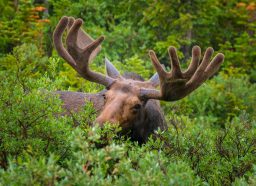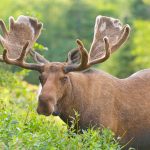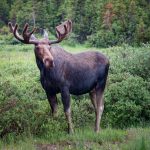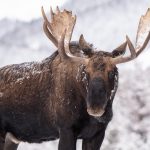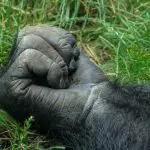Almost all members of the deer family grow antlers for the breeding season. In moose it is only the male who grows them, to defend his breeding rights.
Do Both Male And Female Moose Have Antlers?
Although there are some species of the deer family (Cervidae) where both males and females grow antlers (in caribou for example) female moose do not. Only the males grow the enormous antlers that have become an icon for giant wildlife – especially in North America. Spanning up to 1.8m (5ft 9in) wide – these impressive antlers are a sight to behold.
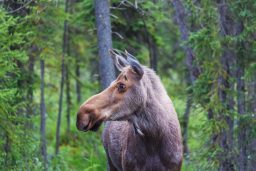
Female moose choose a mate based on the size of the antlers – so they have indirectly over time made the moose’s antlers larger and larger.
Each successive generation creates males with stronger and stronger necks to support such a weight – one large male had antlers weighing 36kg!
The males have to grow a new set every year from scratch by consuming extra nutrients and then they must carry them around for months at a time. They also need to battle with them when they are at the peak of breeding fitness before losing them again as winter sets in.
Why Do Moose Shed Their Antlers?
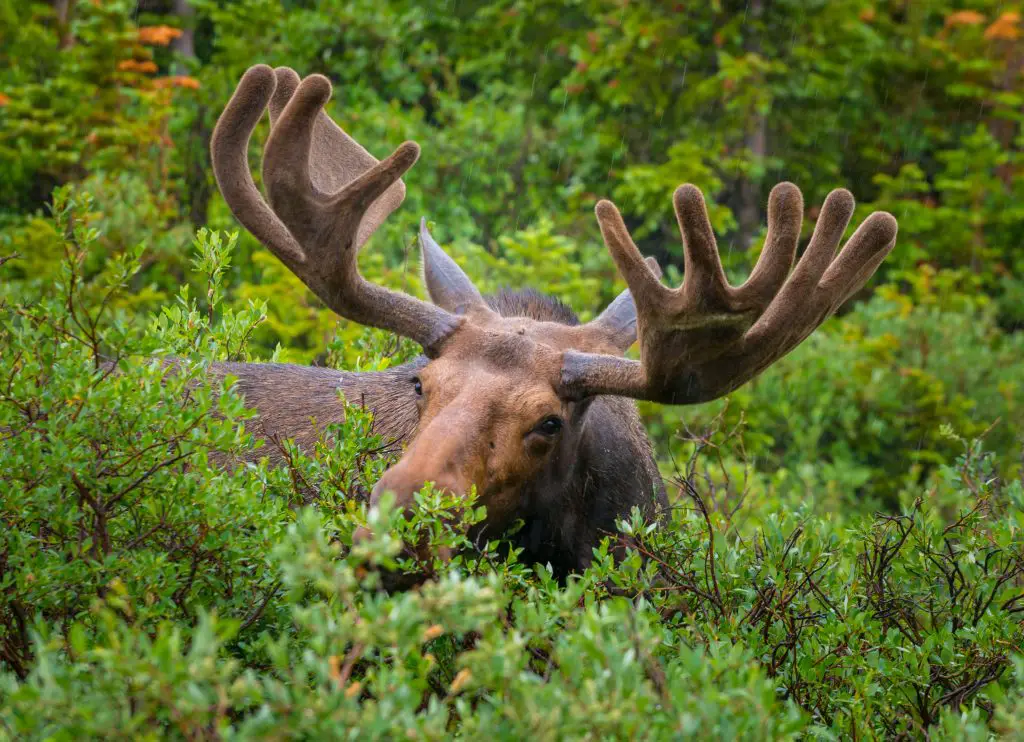
The deer family (including caribou, elk, deer, and muntjacs) all have annual antlers. These bony structures grow over a period of around 5 months and can grow as fast as an inch a day for some deer.
However, due to their size and weight, they use up a lot of energy to carry around.
So, when the breeding season is over and they are no longer needed – dropping them can save the males energy over the winter when food is more scarce. Carrying 10-20kg (22-44lbs) less on your head certainly has its survival advantages.
However, they take a lot of energy to grow in the first place, so some young males may well keep their antlers all winter. As they aren’t too big in the younger males anyway, the energy used to carry them around far outweighs the energy needed to grow a new set.
They eventually need to shed them though as once the velvet is lost they stop growing – and as a healthy ‘suitable’ male needs the biggest antlers possible to woo the ladies, they need to get growing.
Are Moose A Type Of Deer?
Yes and no. Moose belongs to the larger family of deer-like mammals and as a result, are in the same group of mammals as all the ‘true deer’ such as the Red Deer (Cervus elaphus) and Fallow Deer (Dama dama) – but they are in another branch of that larger family – along with caribou (Rangifer tarandus) and Red Brocket (Mazama americana).
They share all the main features of the group – even-toed, antler-growing ruminants – as well as some of the other key deer-like features including having an annual rut, having long, reddish-brown fur, and browsing on young shrubs and grasses.
They also live in colder forests and landscapes as with many other larger members of this family.
Do Moose Sleep Standing Up?
Do moose sleep standing up? Yes, moose sleeping habits are unique as they can sleep either standing or lying down. Their long legs provide stability while standing, allowing them to quickly escape from potential predators. However, when lying down, they can experience a deeper and more restful sleep.
Are Moose The Same As Elk?
Yes and no again. There has always been some confusion between the North American Elk and the Eurasian Elk and this is where the moose gets all confused. Technically the moose is an elk and at the same time, it isn’t an elk. You just need to know your elks!
Read our full article on the difference between Mooses and Elks
North American Elk: the Wapiti:
This elk –Cervus canadensis – is a huge relative of the Red Deer (Cervus elaphus) – a deer we already know isn’t related to the moose (Alces alces). It is half the size of a moose – and twice the size of a red deer. It has pointed antlers like a red deer rather than giant palmate ones like a moose.
Eurasian Elk:
This elk (Alces alces) is biologically identical to the Moose (Alces alces) as they evolved from the same identical ancestors – they just moved to live in different places over time. There are variations in their sizes and colors due to this distance and the centuries that have passed since they all lived in the same place – but they are technically identical in terms of species. The only difference is that elk live in Eurasia and moose live in North America.

